AMD's 785G Chipset - Revolutionary or Evolutionary?
by Gary Key on August 4, 2009 5:00 AM EST- Posted in
- Motherboards
Sorenson Squeeze 5.01
We are using Sorenson Squeeze to convert eight AVCHD videos into HD Flash videos for use on websites.
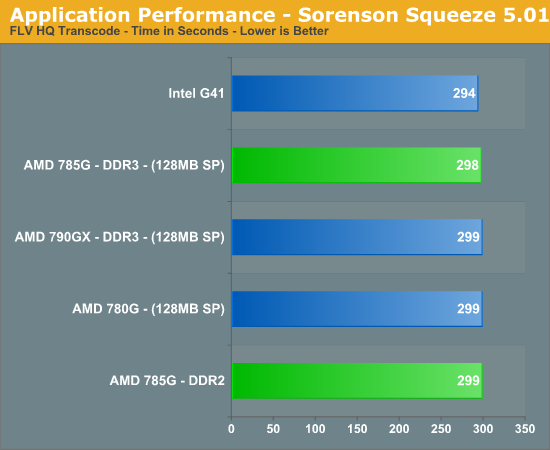
Our Intel platform holds a slight 2% advantage over the AMD systems in an application that typically favors processor core speed.
MainConcept Reference 1.61
One of our favorite video transcoding utilities is MainConcept Reference. We set our profile to iPOD HQ NTSC and then transcode a 651MB 1080P file to a iPOD friendly 34.7MB file.
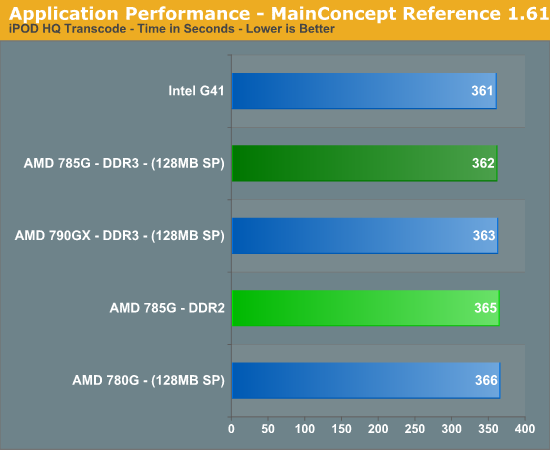
We will call this one a tie and move on.
Sony Vegas Pro 9.0 x64
We transcode a 370MB 1080AVCHD file using the Mainconcept MPEG-2 1920x1080 60i, 25Mbps setting with 6-channel audio.
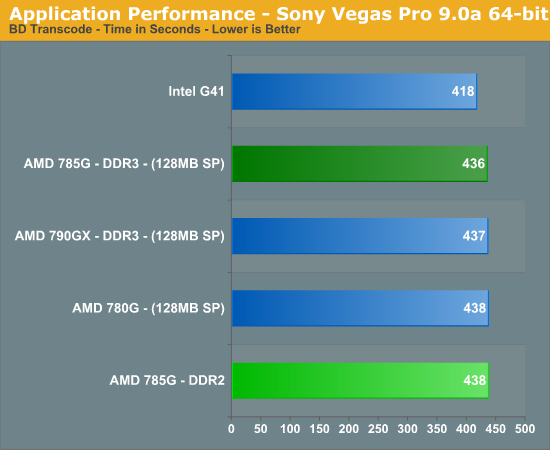
The G41/E6300 combination holds a 4% advantage over the 785G/x2 250 setup.
CyberLink MediaShow Espresso
We transcode a 370MB 1080AVCHD file into a HD friendly file suitable for publishing on YouTube. This program features GPU hardware accelerated decoding via ATI Stream or NVIDIA CUDA. The 785G fully supports this function and is enabled in our test routines.

The ability of the 785G to offload transcoding to the GPU allows it to complete our test 29% faster than the G41. We notice an almost 12% improvement over the 780G/790GX or when we disable hardware decoding on the 785G.
Photoshop CS4 x64
To measure performance under Photoshop CS4 x64, we turn to the Retouch Artists’ Speed Test macro only with a custom image sized at 4800x3600. The test performs basic photo editing; a few color space conversions, several layer creations, color curve adjustment, 3x image and canvas size adjustments, unsharp mask, and finally a gaussian blur performed on the entire image.
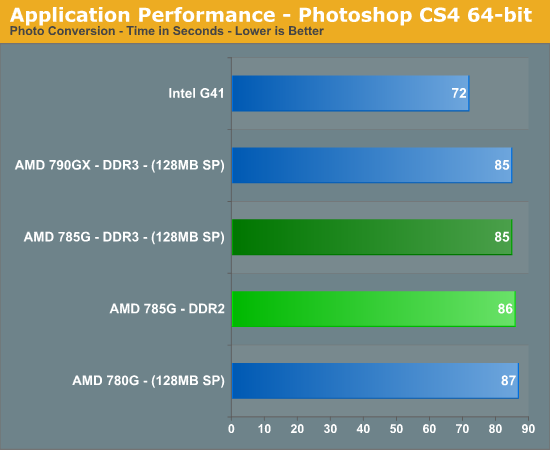
Another unusual result as Photoshop typically responds to CPU speed and memory bandwidth. The G41 configuration holds a 16% advantage over the 785G setup.
Bibble 5
We utilize Bibble Labs’ Bibble 5 v2 to convert 50 RAW image files into full size JPEG images with the program’s default settings. This program is fully multithreaded and multi-core aware.
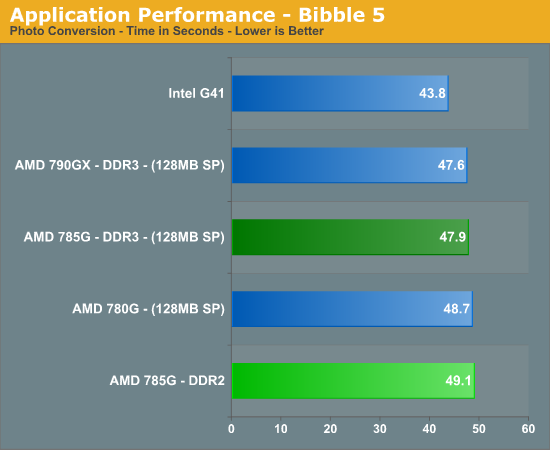
The G41 is 9% quicker than the 785G in a program that AMD recommends for testing their processors. We have noticed in off line testing that the program responds well to improvements in cache latencies. In fact, increasing the Northbridge speed on our Athlon II x2 250 from 2GHz to 2.4GHz decreased our conversion time from 47.9 seconds to 45.6 seconds.










43 Comments
View All Comments
Hrel - Saturday, August 22, 2009 - link
You showed Nvidia stats on the first page... I guess you didn't include them cause ATI and Intel can't even compare???Next time include the Nvidia results... would've thought that it'd an impulsory action; guess not.
crochat - Tuesday, August 18, 2009 - link
Gary,You mentioned a motherboard roundup in your conclusion. I thought it would come sooner.
Regards
AlB80 - Sunday, August 16, 2009 - link
1. The A-Link Express II is a proprietary interface developed by AMD basing on the PCI Express Gen2 version 2.0 technology, with additional Northbridge-Southbridge messaging functionalities.2. High data transfer bandwidth (up to 2.5 Gb/s / Lane)
Concillian - Saturday, August 15, 2009 - link
"Remember when ATI made crappy chipsets that no one bought, and all AMD systems were built with NVIDIA or even VIA chipsets? "Yeah, I remember that, thats when they were really AMD chipsets and not ATi chipsets with an AMD label on them. ATi started making good Crossfire chipsets shortly before AMD bought them.
I like AMD as much as the next guy, but let's not be patting them on the back too hard. They tried, failed, then did what any good American businessman would do... bought a struggling competitor to use their IP.
IntelUser2000 - Saturday, August 8, 2009 - link
Gary, you got the clock speed of the G41 IGP wrong:http://www.techarp.com/showarticle.aspx?artno=543&...">http://www.techarp.com/showarticle.aspx?artno=543&...
G41 and G43 uses a 667MHz core while G45 uses 800MHz.
Notice the differences here: http://global.hkepc.com/1525/page/3#view">http://global.hkepc.com/1525/page/3#view
ClagMaster - Saturday, August 8, 2009 - link
The 785G is just a 780G which has recieved a fine tuning. Which is OK. There are slight improvements in performance over the 780G but nothing to be excited about. 785G Seems to work well with DDR3 memory and Athlon II processors.I have an ASUS M3A78EM 780G Mobo with an AMD BE2400 X2 CPU I use as a secondary computer I keep off-line for private matters. It's a fairly powerful rig for the media applications I run.
The HD 3200 GPU is just as powerful as a Geforce 4200 graphics card. I can play DX8 and DX9 games from the 2002-2004 period (Max Payne, Aquanox, Homeworld2) with acceptable framerates at 1280 x 1024 resolution. I run Windows XP Home.
The 785G is not bad. But if I had a choice between a 785G mobo and a 780G mobo with the 780G costing $5-$10 less, I would buy the 780G mobo. I can still run Windows 7 with the 780G with the HD3200.
ClagMaster - Saturday, August 8, 2009 - link
BTW-This article was not boring. It honestly compared the performance capabilities of the 785G to other chipsets of its class (780G and G41).
Most differences between the 785G and 780G were small and within the combined statistical uncertainty of the benchmark measurements measurements +/-10% (i.e. statistically insignificant). Not very surprising. Most of the larger differences observed were between systems with DDR2-1066 and DDR3-1333 memory systems.
I agree the 785G is a better balanced chipset than the 780G and G41 for multimedia.
I wish Gary would have used an older benchmarking suite so I can compare the performance between current and systems 2-3 years old. I prefer PCMark2005 and 3DMark2005 since these are reliable indicators of performance. This is important to me because I try to make my purchasing decisions on the criteria of having double the performance for the same cost and power consumption.
ClagMaster - Saturday, August 8, 2009 - link
BTW-This article was not boring. It honestly compared the performance capabilities of the 785G to other chipsets of its class (780G and G41).
Most differences between the 785G and 780G were small and within the combined statistical uncertainty of the benchmark measurements measurements +/-10% (i.e. statistically insignificant). Not very surprising. Most of the larger differences observed were between systems with DDR2-1066 and DDR3-1333 memory systems.
I agree the 785G is a better balanced chipset than the 780G and G41 for multimedia.
I wish Gary would have used an older benchmarking suite so I can compare the performance between current and systems 2-3 years old. I prefer PCMark2005 and 3DMark2005 since these are reliable indicators of performance. This is important to me because I try to make my purchasing decisions on the criteria of having double the performance for the same cost and power consumption.
7Enigma - Thursday, August 6, 2009 - link
Gary,Thanks for the article but could you keep in mind for future articles on non-gaming hardware (i.e. IG's, budget GPU's, etc.) to make sure the game description is in line with the actual article? I can tell they were just copied directly from a previous gaming article, so it's a bit silly to see, "We crank up all the details to max", only to see the data chart show 1024X768 with low settings.
:)
AlB80 - Wednesday, August 5, 2009 - link
DMI 10Gb/s each direction, full duplexaka
4 lane PCIe 1.1